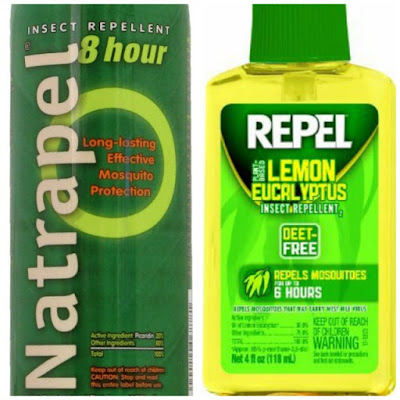I consider insect repellent a necessary evil. Back in the day when the only grief from mosquitos was itchy bites, more often than not I chose not to bother with the stuff. But today, with disease-carrying mosquitos and now tick concerns, protecting yourself from pests is a serious health issue.
The downside of DEET:
Most government resources recommend insect repellents that contain DEET to provide maximum protection from mosquitos and ticks. DEET has been proven to be effective against insects, and it is approved by Health Canada, but there is a body of research that shows the down side of the chemical.
DEET exposure can cause neurological harm in people who used it often (once a day for five days or more). Children are more at risk from the effects of any chemical especially those applied to the skin since it seeps into your body. (DEET is a member of the same chemical family as solvents used in paint removers).
It presents an impossible choice: avoid DEET and run the risk of contracting a debilitating disease through an insect bite, or use DEET and possibly suffer some undetermined long-term toxic effects.
The promise of picaridin:
There is a new active ingredient that has proven very effective and less toxic than DEET. Called picaridin, It’s a synthetic compound that’s a derivative of compounds found in black pepper.
According to Treehugger.com, studies show that picaridin performs as well as DEET and the U.S. Environmental Protection Agency says it is effective against mosquitoes and ticks for 8 to 14 hours. Repellents with picaridin as an active ingredient are recommended by the World Health Organization.
As further proof that there are effective alternatives to DEET, Consumer Reports 2016 insect repellent rating lists three non-DEET repellents in the top five of 15 repellents reviewed (including Deepwoods Off!). Two contain picaridin.
Top rated formula: Sawyer Fisherman’s Formula Picaridin. Active ingredients: Picaridin 20%. I couldn’t find a Canadian source for this product and Amazon won’t ship it to Canada,
Second best: Repel Lemon Eucalyptus.
Active ingredients: Oil of lemon eucalyptus 30% Available through Amazon.ca
Fourth best: Natrapel 8 Hour Active ingredients: Picaridin 20% Available through Amazon.ca
Although there are no long-term tests for picaridin it doesn’t have the same neurotoxicity worries as DEET.
According to EnvironmentalWorking Group, picaridin has the same advantages as DEET without all of the disadvantages.
No product is 100 percent effective against mosquitos and ticks so remember that clothing offers good chemical-free protection (pants, socks, long sleeved shirts). As well, if you have been outside the key preventative measure is to check your body for ticks especially in warm, moist areas like armpits, nape of the neck, back of the knees and groin area.
How to use DEET safely:
If you do choose a product containing DEET, keep this in mind: A higher concentration doesn’t offer better protection, just longer protection. Children (12 and under) shouldn’t use concentrations any higher than 10%. It should be applied sparingly and not to the face or hands. DEET should not be applied more than once a day. Also, be sure to abide by all of the instructions on the label.
Risk if inhalation is high for any product that is pump or spray so take care applying your repellent.
Avoid sunscreen-insect repellent combinations.






